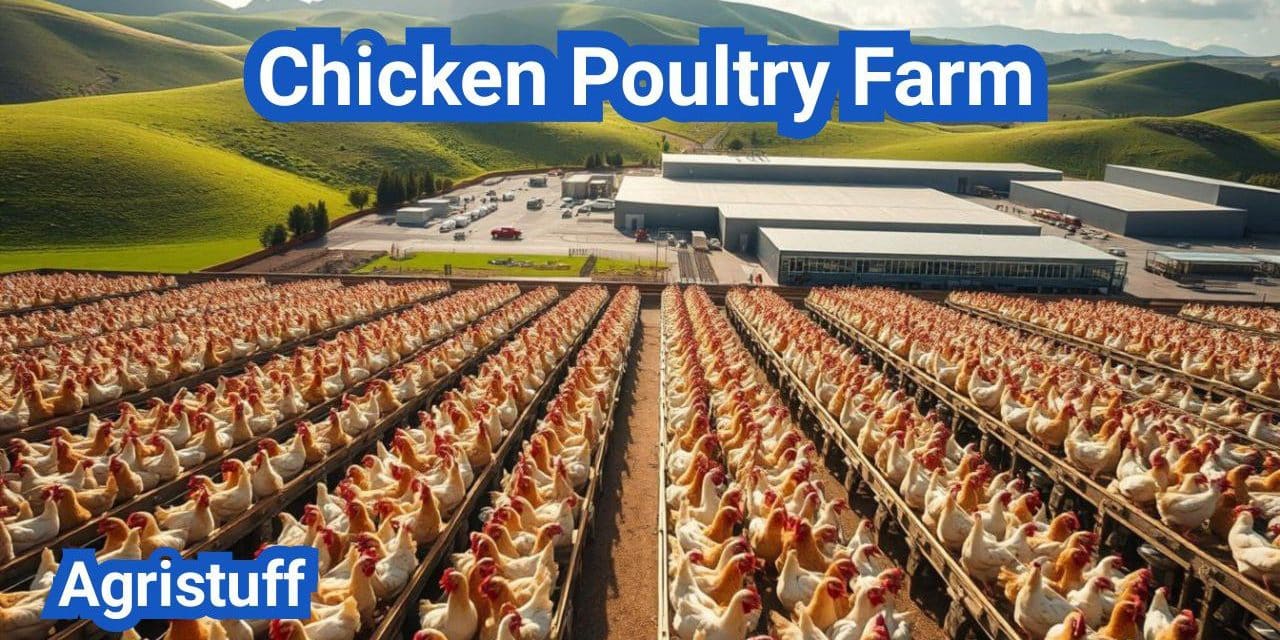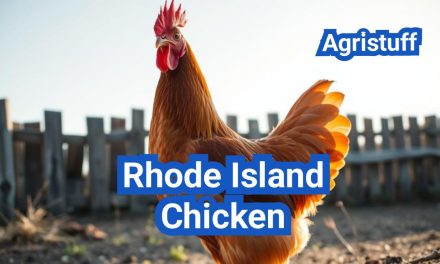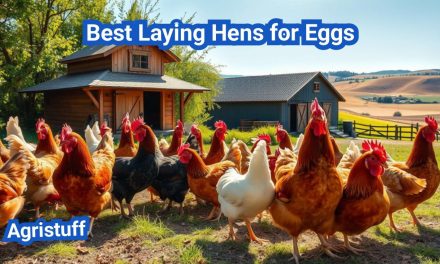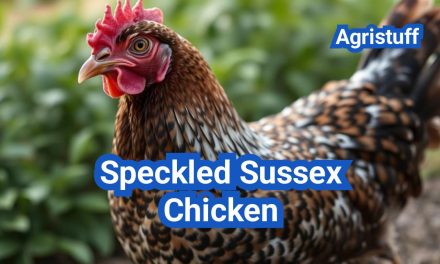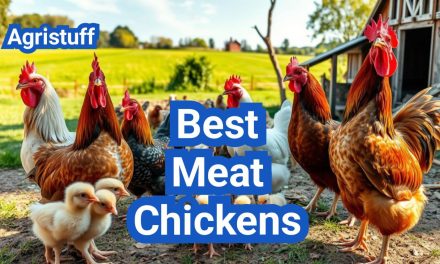Running a profitable chicken poultry farm requires careful planning, efficient management, and a deep understanding of the poultry industry. With Americans consuming over 101.2 pounds of chicken per person in 2023, according to the National Chicken Council, the demand is high, presenting a significant opportunity for farmers.
The key to success lies in understanding the intricacies of poultry farming and implementing effective business strategies. This includes managing resources, optimizing production processes, and adopting innovative marketing techniques to stand out in a competitive market.
Key Takeaways
- Careful planning is crucial for a profitable chicken poultry farm.
- Understanding the poultry industry is key to success.
- Efficient management and resource allocation are vital.
- Innovative marketing strategies can help differentiate your business.
- Optimizing production processes improves profitability.
The Fundamentals of Chicken Poultry Farm Business
The US poultry industry is a significant sector with a combined value of production from broilers, eggs, turkeys, and chicken sales reaching $67.1 billion in 2023. This substantial figure underscores the importance of understanding the fundamentals of running a chicken poultry farm business.
Current Market Trends in US Poultry Industry
The US poultry market is influenced by various factors, including consumer demand, production costs, and global market dynamics. Current trends indicate a shift towards more sustainable and humane farming practices, with consumers willing to pay a premium for products that meet these criteria.
Additionally, the rise of alternative protein sources has prompted the industry to innovate and adapt. Market research is crucial for understanding these trends and making informed decisions about production and marketing strategies.
Types of Poultry Operations: Commercial vs. Small-Scale
Poultry operations can be broadly categorized into commercial and small-scale farms. Commercial poultry operations are large-scale enterprises that focus on high-volume production, often utilizing advanced technology and management practices to maximize efficiency and profitability.
In contrast, small-scale poultry farms typically cater to local markets or niche consumer segments. These operations may focus on specialty products or alternative production methods, such as organic or free-range poultry.
Profitability Factors in Different Poultry Sectors
Profitability in the poultry industry is influenced by several factors, including production costs, market prices, and operational efficiency. Efficient feed conversion ratios and effective disease management are critical for maintaining profitability, particularly in the broiler sector.
The egg production sector also faces unique challenges, such as fluctuating feed costs and consumer preferences for cage-free or organic eggs. Understanding these factors is essential for developing a successful business strategy.
Creating a Comprehensive Poultry Farm Business Plan

A comprehensive business plan serves as a roadmap for your poultry farming venture, outlining the steps necessary to achieve success and profitability.
Developing a thorough business plan involves several key components. It begins with understanding the current market trends and consumer demands.
Market Research and Feasibility Analysis | Chicken Poultry Farm
Conducting market research is crucial to understand the demand for poultry products in your area. This involves analyzing consumer preferences, competitor activity, and market trends.
A feasibility analysis helps determine whether your poultry farm business is viable by assessing factors such as location, resources, and potential returns on investment.
Financial Projections and Capital Requirements | Chicken Poultry Farm
Creating detailed financial projections is essential for securing investments and managing your farm’s finances effectively. This includes estimating startup costs, operational expenses, and revenue projections.
Understanding your capital requirements helps in planning for the necessary funds to establish and grow your poultry farm business.
| Expense Category | Initial Investment | Ongoing Expenses |
|---|---|---|
| Land and Infrastructure | $100,000 | $5,000/year |
| Equipment and Machinery | $50,000 | $2,000/year |
| Feed and Supplies | $20,000 | $10,000/year |
Setting Clear Business Goals and Timelines | Chicken Poultry Farm
Establishing clear business goals and timelines is vital for measuring progress and staying on track. This involves setting specific, measurable, achievable, relevant, and time-bound (SMART) objectives.
By creating a comprehensive business plan that includes market research, financial projections, and clear business goals, you can ensure the success and profitability of your poultry farm.
Legal Requirements for Starting a Poultry Farm
Poultry farming is a heavily regulated industry, and prospective farmers must be aware of the various legal requirements to operate successfully. Compliance with these regulations is not only mandatory but also crucial for the long-term sustainability of the farm.
Permits, Licenses, and Certifications Needed | Chicken Poultry Farm
To start a poultry farm, you will need to obtain several permits, licenses, and certifications. These may include:
- Business License: Required to operate a business in your state or locality.
- Poultry Farm Permit: Specific to poultry farming, this permit ensures your operation meets local agricultural regulations.
- Health Department Permit: Necessary for ensuring the health and safety of your flock and the surrounding community.
- Environmental Permits: Required for managing waste and ensuring environmental compliance.
As stated by the USDA’s National Agricultural Statistics Service, “Poultry farms must comply with a myriad of regulations to ensure the health of the flock and the environment.”
Zoning Regulations and Land Requirements | Chicken Poultry Farm
Zoning regulations play a critical role in determining where you can locate your poultry farm. These regulations vary by locality and are designed to ensure that agricultural activities do not negatively impact nearby residential areas or other businesses.
When selecting a site for your poultry farm, consider the following:
- Proximity to Residential Areas: Farms are often required to be a certain distance from residential zones to minimize disturbances.
- Land Size: Ensure you have enough land to accommodate your flock and to manage waste effectively.
- Access to Resources: Proximity to feed suppliers, veterinary services, and markets is crucial.
Environmental Compliance and Waste Management Standards | Chicken Poultry Farm
Poultry farming has significant environmental implications, particularly regarding waste management. Farms must comply with regulations designed to minimize environmental impact.
Key aspects of environmental compliance include:
- Waste Management Plans: Developing and implementing plans to manage manure and other waste.
- Water Quality Protection: Ensuring that farm operations do not contaminate local water sources.
- Air Quality Standards: Managing dust and other emissions to comply with air quality regulations.
“The poultry industry is under increasing scrutiny for its environmental impact. Farms that adopt sustainable practices not only comply with regulations but also contribute to a healthier environment.”
By understanding and complying with these legal requirements, poultry farmers can ensure their operations are successful and sustainable.
Selecting the Right Chicken Breeds for Your Goals

Choosing the right chicken breed is crucial for the success of your poultry farm. Different chicken breeds are suited for different purposes, such as egg-laying, meat production, or dual-purpose uses. Understanding these differences is key to optimizing your farm’s productivity and profitability.
Best Egg-Laying Chicken Breeds for Productivity
For farms focused on egg production, selecting breeds known for their high laying capacity is essential. Breeds like the Leghorn and Rhode Island Red are renowned for their ability to produce a large number of eggs. The Leghorn, for instance, can lay up to 300 eggs per year, making it an ideal choice for commercial egg production.
Other notable egg-laying breeds include the Barred Plymouth Rock and Sussex, known for their consistent laying and friendly disposition. These breeds not only provide a steady supply of eggs but are also relatively easy to manage.
Top Broiler Chicken Breeds for Meat Production
For farms focused on meat production, broiler chicken breeds are the way to go. Breeds such as the Cornish Cross are specifically bred for their fast growth rate and high-quality meat. The Cornish Cross is a popular choice among commercial broiler producers due to its efficiency and the tender meat it produces.
Other broiler breeds worth considering include the Ross 308 and Arbor Acres, known for their rapid growth and robust health. These breeds are optimized for meat production, making them ideal for farms looking to capitalize on the demand for high-quality chicken meat.
Heritage and Dual-Purpose Chicken Breeds
Heritage and dual-purpose chicken breeds offer a unique value proposition for farmers looking to diversify their products. Breeds like the Plymouth Rock and Wyandotte are not only good layers but also provide high-quality meat, making them ideal for farms looking to produce both eggs and meat.
These heritage breeds are often prized for their hardiness, foraging ability, and rich flavor profile. They can be a great choice for farmers looking to enter niche markets or differentiate their products from those of larger commercial operations.
In conclusion, selecting the right chicken breed is a critical decision that depends on your farm’s specific goals and market focus. Whether you’re producing eggs, meat, or both, there’s a chicken breed suited to your needs. By understanding the characteristics and advantages of different breeds, you can make an informed decision that enhances your farm’s productivity and profitability.
Essential Chicken Poultry Farm Equipment
Running a profitable chicken poultry farm requires not only a well-thought-out business plan but also the right equipment to ensure the health and productivity of the chickens. The right equipment is crucial for maintaining a healthy and productive flock, and it plays a significant role in the daily operations of the farm.
Housing Systems: Battery Cages vs. Furnished Cages
The housing system is one of the most critical components of a poultry farm. There are different types of housing systems, including battery cages and furnished cages. Battery cages are designed to maximize egg production while minimizing space and costs. However, they have faced criticism due to animal welfare concerns.
Furnished cages, on the other hand, provide a more comfortable environment for the chickens, offering features such as nesting boxes, perches, and scratching areas. While they are more expensive than battery cages, they can improve the welfare of the chickens and potentially increase productivity.
Feeding and Watering Equipment Options | Chicken Poultry Farm
Efficient feeding and watering systems are vital for the health and productivity of the chickens. There are various types of feeding equipment, including automatic feeders and manual feeding systems. Automatic feeders can save labor and ensure that the chickens are fed consistently.
Watering equipment is also crucial, and options range from nipple drinkers to bell drinkers. Nipple drinkers are popular due to their ability to reduce waste and keep the water clean.
Climate Control and Ventilation Systems | Chicken Poultry Farm
Maintaining a comfortable climate is essential for the health and productivity of the chickens. Climate control and ventilation systems help regulate the temperature and air quality within the poultry house. Ventilation systems are designed to remove moisture, ammonia, and other gases from the poultry house, improving air quality.
Heating and cooling systems are also important for maintaining a comfortable temperature. These systems can be adjusted according to the age and type of chickens being raised.
Egg Collection and Processing Equipment
For farms that specialize in egg production, efficient egg collection and processing equipment are crucial. Automated egg collection systems can significantly reduce labor costs and improve the cleanliness of the eggs.
Egg washing and grading equipment are also important for ensuring that the eggs are clean and sorted according to size and quality.
Setting Up Optimal Housing Infrastructure

A well-designed poultry housing system is essential for maximizing the potential of your chicken flock. The housing infrastructure plays a critical role in ensuring the health, welfare, and productivity of chickens.
Space Requirements and Stocking Density Guidelines | Chicken Poultry Farm
Providing adequate space is crucial for the well-being of chickens. Overcrowding can lead to stress, disease, and reduced productivity. The stocking density should be carefully planned to ensure that chickens have enough room to move, feed, and rest.
Industry guidelines recommend specific space requirements based on the age, size, and breed of chickens. For instance, layers typically require more space than broilers. It’s essential to consult with poultry experts and follow local regulations when determining the optimal stocking density for your farm.
Different Housing Systems: Pros and Cons | Chicken Poultry Farm
There are various housing systems used in poultry farming, each with its advantages and disadvantages. The most common systems include battery cages, furnished cages, aviaries, and free-range systems.
- Battery cages are cost-effective but have raised welfare concerns.
- Furnished cages offer more space and amenities for chickens.
- Aviaries provide chickens with the freedom to move vertically.
- Free-range systems allow chickens to roam outdoors, enhancing their welfare.
Each system has its pros and cons, and the choice depends on factors like farm size, budget, and target market.
Creating a Comfortable Environment for Maximum Productivity | Chicken Poultry Farm
Creating a comfortable environment is vital for maximizing productivity. This involves controlling temperature, humidity, and lighting within the poultry house. Ventilation systems are crucial for maintaining air quality and removing harmful gases.
In addition to physical comfort, reducing stress is essential. This can be achieved by providing enrichment activities and ensuring that chickens have access to food, water, and nesting areas without competition.
Hatchery Operations and Breeding Management

A well-managed hatchery is essential for producing healthy chicks and achieving business goals. The hatchery is where the life cycle of chickens begins, and its operations have a significant impact on the overall productivity and profitability of a poultry farm.
Setting Up an On-Farm Hatchery
Setting up an on-farm hatchery requires careful planning and investment in the right equipment. The first step is to decide on the size of the hatchery based on the farm’s production needs. It’s crucial to ensure that the hatchery is designed to maintain optimal conditions for incubation, including temperature, humidity, and ventilation.
Key considerations for setting up an on-farm hatchery include:
- Selecting the right incubation equipment, such as setters and hatchers
- Designing the layout to facilitate efficient workflow
- Implementing biosecurity measures to prevent disease outbreaks
Incubation and Hatching Procedures | Chicken Poultry Farm
Incubation and hatching are critical processes that require precise control over environmental conditions. The incubation period for chicken eggs is typically 21 days, during which the eggs must be maintained at a consistent temperature and humidity level.
Best practices for incubation and hatching include:
- Regularly monitoring temperature and humidity levels
- Turning eggs regularly to prevent embryo sticking
- Candling eggs to check for embryo development
Breeding Programs for Genetic Improvement | Chicken Poultry Farm
Breeding programs are essential for genetic improvement and achieving desired traits in chicken populations. These programs involve selecting breeding stock based on specific characteristics, such as growth rate, egg production, and disease resistance.
Key elements of a successful breeding program include:
- Defining clear breeding goals and objectives
- Selecting appropriate breeding stock
- Implementing a record-keeping system to track breeding and production data
By focusing on these aspects of hatchery operations and breeding management, poultry farmers can improve the efficiency and productivity of their operations, ultimately leading to increased profitability.
Effective Poultry Nutrition and Feeding Practices

Effective feeding practices are essential for maintaining healthy chickens and maximizing farm profitability. Nutrition plays a critical role in the health and productivity of chickens, influencing growth rates, egg production, and overall flock health.
Nutritional Requirements at Different Growth Stages | Chicken Poultry Farm
Chickens have different nutritional needs at various stages of their growth. Understanding these requirements is crucial for optimizing feed formulations.
- Starter Phase (0-6 weeks): High protein content (20-22%) is necessary for rapid growth and development.
- Grower Phase (6-18 weeks): Protein levels are reduced (16-18%) as growth rates slow down.
- Laying Phase: Calcium and phosphorus levels are increased to support eggshell production.
Formulating Cost-Effective Feed Rations | Chicken Poultry Farm
Formulating feed rations that meet nutritional requirements while minimizing costs is a key challenge for poultry farmers. This involves selecting the right ingredients and ensuring the feed is palatable and safe for consumption.
| Feed Ingredient | Nutritional Value | Cost Consideration |
|---|---|---|
| Corn | Energy source | Relatively inexpensive |
| Soybean Meal | High protein content | Moderately priced |
| Calcium Carbonate | Essential for eggshell production | Low cost |
Feeding Schedules and Best Practices | Chicken Poultry Farm
Implementing an appropriate feeding schedule is vital for maintaining flock health and optimizing production. Best practices include providing fresh water at all times, avoiding overfeeding, and ensuring feed is consumed within a reasonable timeframe to prevent waste.
By understanding and implementing effective poultry nutrition and feeding practices, farmers can significantly improve the health and productivity of their flocks, leading to increased profitability and sustainability.
Implementing Strong Biosecurity Measures

Maintaining stringent biosecurity protocols is essential for preventing disease outbreaks in chicken poultry farms. Biosecurity measures are critical in protecting the health of the flock, ensuring the quality of products, and maintaining the overall profitability of the farm.
Effective biosecurity involves a multi-faceted approach that includes disease prevention strategies, strict visitor and worker protocols, and rigorous cleaning and disinfection procedures. By implementing these measures, poultry farmers can significantly reduce the risk of disease transmission and maintain a healthy and productive flock.
Disease Prevention Strategies | Chicken Poultry Farm
Disease prevention is a critical component of biosecurity. This involves implementing measures to prevent the introduction and spread of diseases within the flock. Some key strategies include:
- Implementing a vaccination program tailored to the specific needs of the flock.
- Conducting regular health checks and monitoring for signs of illness.
- Maintaining strict control over the movement of people, animals, and equipment within the farm.
As emphasized by poultry health experts, “A proactive approach to disease prevention is far more effective than reactive measures after an outbreak has occurred.”
A well-designed biosecurity plan can significantly reduce the risk of disease transmission and improve overall flock health.
Visitor and Worker Protocols | Chicken Poultry Farm
Strict protocols for visitors and workers are essential to prevent the introduction of diseases into the flock. This includes:
| Protocol | Description |
|---|---|
| Personal Protective Equipment (PPE) | Ensuring that all visitors and workers wear appropriate PPE, including gloves, masks, and coveralls. |
| Footbaths and Disinfection Stations | Installing footbaths and disinfection stations at entrances to poultry houses to prevent the introduction of pathogens. |
| Restricted Access | Limiting access to poultry areas to authorized personnel only. |
Cleaning and Disinfection Procedures | Chicken Poultry Farm
Regular cleaning and disinfection are crucial for maintaining a biosecure environment. This involves:
- Removing soiled bedding and waste regularly.
- Disinfecting all equipment and surfaces with approved disinfectants.
- Drying and aerating poultry houses between flocks to reduce microbial load.
By implementing these strong biosecurity measures, poultry farmers can protect their flocks from disease outbreaks, ensure the quality of their products, and maintain a profitable and sustainable farming operation.
Worker Health and Safety on Poultry Farms

Poultry farming, while a vital sector, poses significant occupational hazards to its workforce. Ensuring the health and safety of workers is not only a moral obligation but also crucial for the sustainability and productivity of the farm.
Common Occupational Hazards in Poultry Farming
Poultry farm workers are exposed to various hazards, including respiratory issues from dust and ammonia, physical injuries from machinery, and zoonotic diseases transmitted from birds to humans. The nature of the work, often involving long hours in challenging conditions, further exacerbates these risks.
Implementing effective safety measures is critical to mitigating these risks. This includes providing appropriate personal protective equipment (PPE), such as masks, gloves, and protective clothing, to reduce exposure to harmful substances and pathogens.
Safety Equipment and Protective Measures | Chicken Poultry Farm
Employers must ensure that all necessary safety equipment is available and that workers are trained in its proper use. Regular maintenance of equipment and facilities is also essential to prevent accidents and ensure a safe working environment.
- Provision of PPE and training on its use
- Regular health check-ups for workers
- Safe handling and disposal of waste
- Implementation of emergency response plans
Training Programs for Farm Workers | Chicken Poultry Farm
Comprehensive training programs are vital for equipping workers with the knowledge and skills needed to perform their tasks safely. These programs should cover hazard recognition, safe work practices, and emergency procedures.
By prioritizing worker health and safety, poultry farms can reduce the risk of accidents, improve worker well-being, and enhance overall productivity.
Daily Operations and Management Practices

The daily management of a poultry farm involves a multitude of tasks that require careful planning and execution. Effective daily operations are crucial for maintaining the health and productivity of the flock, as well as ensuring the overall profitability of the farm.
Daily Routine and Checklist | Chicken Poultry Farm
Establishing a daily routine is essential for the smooth operation of a poultry farm. This routine should include tasks such as feeding, watering, and monitoring the health of the flock. A comprehensive checklist can help ensure that all necessary tasks are completed on a daily basis.
- Inspecting the condition of the poultry housing and equipment
- Monitoring feed and water consumption
- Checking for signs of illness or stress in the flock
- Collecting eggs or monitoring the growth of broilers
- Maintaining records of daily activities and observations
Proper record-keeping is vital for identifying trends and making informed decisions about farm management.
Staff Training and Management | Chicken Poultry Farm
Staff training is a critical component of effective poultry farm management. Employees should be trained in all aspects of daily operations, including animal care, equipment maintenance, and biosecurity protocols.
Regular training sessions can help ensure that staff are up-to-date with the latest best practices and are equipped to handle any challenges that may arise.
Monitoring Flock Health and Performance | Chicken Poultry Farm
Monitoring the health and performance of the flock is essential for identifying potential issues early and taking corrective action. This includes tracking growth rates, feed conversion ratios, and mortality rates.
By closely monitoring these metrics, farmers can make data-driven decisions to optimize flock performance and improve overall farm profitability.
Regular health checks and veterinary consultations can also help prevent and manage disease outbreaks, further ensuring the well-being of the flock.
Small-Scale Poultry Farming Strategies

Many are turning to small-scale poultry farming as a way to enter the poultry industry. This approach allows individuals to start small and grow their business gradually.
Backyard Chicken Farming for Beginners
Backyard chicken farming is an excellent starting point for beginners. It requires minimal investment and can be managed with basic knowledge. To start, one should:
- Choose the right chicken breed for egg-laying or meat production.
- Set up a safe and secure coop to protect the chickens from predators.
- Understand the nutritional needs of chickens at different stages.
Urban Chicken Keeping Considerations
Urban chicken keeping is becoming increasingly popular in cities. However, it comes with specific challenges and regulations. Key considerations include:
- Checking local ordinances regarding the number of chickens allowed.
- Ensuring the coop is compliant with local building codes.
- Managing noise and odor to maintain good neighborly relations.
Scaling from Hobby to Commercial Operation
For those who start with backyard chicken farming as a hobby, scaling up to a commercial operation requires careful planning. This includes:
- Expanding infrastructure to accommodate more chickens.
- Developing a business plan that includes market analysis and financial projections.
- Implementing efficient feeding and health management practices.
By following these strategies, small-scale poultry farmers can successfully transition from a hobby to a profitable business.
Marketing Strategies for Poultry Products
Marketing poultry products requires a multi-faceted approach that includes understanding consumer preferences and leveraging various sales channels. Effective marketing strategies are crucial for differentiating your products in a competitive market.
Direct-to-Consumer Sales Channels
One of the most effective ways to increase profit margins is by selling poultry products directly to consumers. This can be achieved through:
- Farmers’ markets, where you can showcase your products and interact with customers.
- Online platforms, such as e-commerce websites or social media, to reach a wider audience.
- On-farm sales or pick-your-own options, providing customers with a unique experience.
By adopting direct-to-consumer sales channels, farmers can build a loyal customer base and gather valuable feedback.
Wholesale and Retail Partnerships | Chicken Poultry Farm
In addition to direct sales, forming wholesale and retail partnerships can significantly expand your market reach. This involves:
- Establishing relationships with local grocery stores or supermarkets.
- Supplying restaurants and specialty food stores with your poultry products.
- Collaborating with distributors to ensure timely delivery of your products.
These partnerships can help increase brand visibility and open up new revenue streams.
Building a Brand for Your Farm Products
Branding is a critical component of any marketing strategy, as it helps to differentiate your products from those of competitors. To build a strong brand:
- Develop a unique brand identity that reflects your farm’s values and mission.
- Use packaging and labeling that is both attractive and informative.
- Engage in storytelling to share the story behind your farm and products.
By creating a compelling brand, you can foster customer loyalty and justify premium pricing for your products.
Organic and Sustainable Poultry Farming
As consumers become more environmentally conscious, the demand for organic and sustainably produced poultry products is on the rise. This shift is driving the growth of organic and sustainable poultry farming practices across the United States.
Organic poultry farming involves raising chickens without the use of antibiotics, hormones, or genetically modified organisms (GMOs). This method not only appeals to consumers looking for healthier options but also promotes better animal welfare and environmental sustainability.
Certification Requirements and Process | Chicken Poultry Farm
To label poultry products as “organic,” farmers must undergo a rigorous certification process. This involves meeting strict USDA guidelines, including:
- Providing organic feed
- Avoiding the use of antibiotics and hormones
- Ensuring access to the outdoors
- Maintaining detailed records of farming practices
According to the USDA, “Organic farming practices foster a sustainable ecosystem by promoting soil health, biodiversity, and efficient water use.”
“The organic label is a guarantee that the product was produced using farming practices that preserve the environment and conserve natural resources.”
Pasture-Raised and Free-Range Production Systems
Pasture-raised and free-range production systems are gaining popularity as they offer chickens more space to roam and engage in natural behaviors. These systems not only improve animal welfare but can also result in more nutritious and flavorful poultry products.
A study on pasture-raised chickens found that they had higher levels of omega-3 fatty acids and vitamins A and E compared to conventionally raised chickens. Pasture-raised production involves rotating chickens through pastures to mimic natural conditions, promoting healthier chickens and pastures.
Sustainable Waste Management Solutions | Chicken Poultry Farm
Sustainable waste management is crucial in organic and sustainable poultry farming. Farmers are adopting innovative methods to manage waste, such as composting and using waste as fertilizer. These practices not only reduce environmental impact but also create additional revenue streams for farmers.
By embracing organic and sustainable practices, poultry farmers can meet the growing demand for environmentally friendly products while contributing to a more sustainable agricultural sector.
Keys to a Profitable Chicken Poultry Farm
Running a profitable chicken poultry farm requires careful planning and management. By understanding the fundamentals of the business, creating a comprehensive business plan, and implementing effective strategies, farmers can achieve success.
The keys to a profitable chicken poultry farm include selecting the right chicken breeds, investing in essential equipment, and maintaining optimal housing infrastructure. Effective poultry nutrition, biosecurity measures, and worker health and safety are also crucial.
By following these guidelines and staying focused on their goals, farmers can build a thriving and profitable chicken poultry farm. Whether you’re starting a small-scale or commercial operation, the principles outlined in this article can help you achieve success and create a sustainable business.
FAQ
What are the key factors to consider when starting a chicken poultry farm?
When starting a chicken poultry farm, it’s essential to consider factors such as market trends, types of poultry operations, profitability factors, and legal requirements. A comprehensive business plan, including market research, financial projections, and clear business goals, is also crucial.
What are the different types of chicken breeds suitable for poultry farming?
There are various chicken breeds suitable for different purposes, including egg-laying breeds like Leghorns, broiler breeds like Cornish Cross, and heritage breeds like Plymouth Rock. The choice of breed depends on the farm’s goals and production systems.
What are the essential equipment required for a chicken poultry farm?
Essential equipment for a chicken poultry farm includes housing systems, feeding and watering equipment, climate control systems, and egg collection and processing equipment. The type and quality of equipment depend on the farm’s size, production systems, and budget.
How can I ensure optimal housing infrastructure for my poultry farm?
To ensure optimal housing infrastructure, consider factors such as space requirements, stocking density guidelines, and different housing systems. Creating a comfortable environment for the chickens is crucial for maximum productivity.
What are the key aspects of hatchery operations and breeding management?
Key aspects of hatchery operations and breeding management include setting up an on-farm hatchery, incubation and hatching procedures, and breeding programs for genetic improvement. Effective hatchery operations and breeding management are critical for producing high-quality chicks.
How can I implement strong biosecurity measures on my poultry farm?
To implement strong biosecurity measures, consider disease prevention strategies, visitor and worker protocols, and cleaning and disinfection procedures. Biosecurity is critical for preventing disease outbreaks and maintaining flock health.
What are the nutritional requirements of chickens at different growth stages?
Chickens have different nutritional requirements at various growth stages. For example, broiler chickens require high-protein feed during the starter phase, while laying hens require calcium-rich feed during the laying phase. Formulating cost-effective feed rations is essential for maintaining profitability.
How can I market my poultry products effectively?
Effective marketing strategies for poultry products include direct-to-consumer sales channels, wholesale and retail partnerships, and building a brand for your farm products. Understanding your target market and developing a marketing plan is crucial for increasing sales and revenue.
What are the benefits of organic and sustainable poultry farming practices?
Organic and sustainable poultry farming practices offer several benefits, including improved animal welfare, environmental sustainability, and increased market demand. Organic certification requirements and process, pasture-raised and free-range production systems, and sustainable waste management solutions are essential for maintaining organic and sustainable practices.
How can I ensure worker health and safety on my poultry farm?
Ensuring worker health and safety on a poultry farm involves identifying common occupational hazards, providing safety equipment and protective measures, and implementing training programs for farm workers. A safe working environment is essential for maintaining a productive and healthy workforce.
What are the key daily operations and management practices for a poultry farm?
Key daily operations and management practices for a poultry farm include daily routine and checklist, staff training and management, and monitoring flock health and performance. Effective daily operations and management practices are critical for maintaining a productive and healthy flock.
Conclusion Of: Chicken Poultry Farm
Operating a chicken poultry farm is a lucrative opportunity for entrepreneurs looking to enter the agricultural sector in the USA. A chicken poultry farm primarily focuses on producing eggs and meat, meeting consistent consumer demands and contributing significantly to local economies. Learn more about the economic impact of poultry farming from the USDA’s National Agricultural Statistics Service.
Why Invest in a Chicken Poultry Farm
A chicken poultry farm offers stable income potential due to the steady market demand for poultry products. It requires relatively modest startup costs compared to other agricultural ventures, making it accessible to beginners. For insights on poultry industry trends, refer to the American Egg Board’s market data.
Choosing the Right Poultry Breeds
Selecting appropriate breeds for your chicken poultry farm is crucial for profitability. For egg production, breeds like Leghorns and Rhode Island Reds are ideal, whereas Cornish Cross and Freedom Rangers excel in meat production. The University of Georgia Extension provides detailed breed comparisons.
Selecting Farm Location
Choosing the optimal location for your chicken poultry farm involves evaluating factors such as accessibility, proximity to markets, availability of water resources, and land quality. A well-selected location directly contributes to operational efficiency and profitability. The Penn State Extension offers a guide on farm site selection.
Building Effective Housing
Proper housing is fundamental for the success of a chicken poultry farm. The housing should be spacious, well-ventilated, secure from predators, and able to withstand diverse weather conditions, ensuring the health and productivity of the poultry. For housing best practices, see the Mississippi State University Extension.
Essential Poultry Equipment
Equipping your chicken poultry farm with essential tools is key to operational success. Necessary equipment includes feeders, drinkers, nest boxes, incubators, heating and cooling systems, and proper lighting. The Iowa State University Extension outlines equipment recommendations.
Feeding and Nutrition
Proper feeding practices are critical in a chicken poultry farm. A balanced diet comprising grains, protein, vitamins, minerals, and adequate fresh water ensures optimal poultry health and productivity. The University of Kentucky Poultry Science Department provides feeding guidelines.
Disease Prevention and Health Management
Effective disease prevention strategies are crucial in maintaining a profitable chicken poultry farm. Regular vaccinations, proper sanitation, veterinary care, and biosecurity measures help ensure flock health and minimize losses. The CDC’s poultry health resources offer disease control tips.
Egg Production Management
For egg-focused chicken poultry farms, effective egg production management involves understanding laying patterns, optimizing feed, maintaining cleanliness of nesting areas, and timely egg collection to maximize yield. The University of California Agriculture and Natural Resources shares egg production best practices.
Meat Production Strategies
Chicken poultry farms targeting meat production must prioritize managing feed efficiency, growth rates, and humane poultry processing methods to maintain quality and profitability. The National Chicken Council’s broiler production guide provides industry standards.
Record Keeping and Analysis
Accurate record keeping is essential in running a profitable chicken poultry farm. Monitoring production, expenses, and revenues allows for strategic planning and profitability improvements. The USDA’s Farm Record Keeping Guide offers templates and tools.
Marketing Your Poultry Products
A successful chicken poultry farm implements robust marketing strategies. Explore various marketing channels such as local markets, farmers’ markets, direct sales to consumers, and online platforms to boost visibility and sales. The Small Business Administration’s marketing guide provides actionable tips.
Complying with Regulations
Complying with local, state, and federal regulations is mandatory for operating a chicken poultry farm. Understanding legal requirements regarding poultry welfare, environmental protection, and business operations ensures smooth, sustainable management. The FDA’s Poultry Processing Regulations outline compliance standards.
Common Challenges and Solutions
Running a chicken poultry farm comes with challenges such as disease outbreaks, predator threats, and fluctuating feed costs. Being proactive, staying informed, and implementing robust contingency plans help mitigate these issues. The University of Arkansas Division of Agriculture shares solutions to common poultry farming problems.
Sustainable Practices
Sustainability practices in your chicken poultry farm contribute significantly to long-term success. Implementing waste management systems, resource conservation techniques, and environmentally friendly practices supports business sustainability. The EPA’s AgStar Program offers sustainability resources.
Expansion Opportunities
Once your chicken poultry farm is established, consider expansion opportunities by diversifying poultry products, increasing flock size, or incorporating advanced farming technologies to enhance productivity and profitability. The USDA’s Rural Development Grants support farm expansion.
Final Thought
Operating a chicken poultry farm successfully requires careful planning, strategic management, and continuous learning. By following these guidelines, entrepreneurs can build a profitable and sustainable chicken poultry farming business. For further reading, visit the Poultry Science Association.

